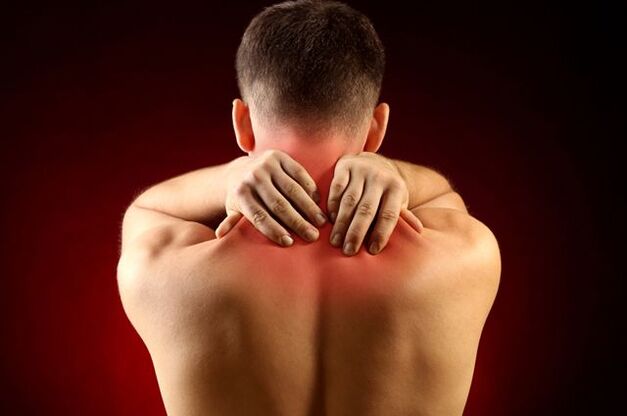Osteochondrosis is a degenerative-dystrophic disease in which the intervertebral disc suffers, types of disease, symptoms and methods of treatment. The central part (nucleus pulposus) of the intervertebral disc first swells and then shrinks, losing its shock-absorbing properties. And the annular fibrosus, located along the periphery of the disc, becomes thin and cracks appear on it.
The central part (nucleus pulposus) of the intervertebral disc first swells and then shrinks, losing its shock-absorbing properties. And the annular fibrosus, located along the periphery of the disc, becomes thin and cracks appear on it.
When the nucleus pulposus enters this crack, a bulge appears, and if the annular fracture, the gelatinous body falls out, forming a herniated disc. With age, the risk of developing osteochondrosis increases significantly.
Bitan
Osteochondrosis can have different localization. The most common type is lumbosacral (in 50% of cases). Cervical osteochondrosis is often found (in 25% of cases), less often osteochondrosis of the thoracic spine. In 12% of cases, the defeat of the intervertebral discs affects several parts of the spine at once - this is the most severe form of the disease.
Whatever its location, the disease has several stages.
Phase 1characterized by instability of spinal segments, which is manifested by a violation of the disc.
Phase 2it is expressed in the fact that the vertebrae are less fixed to each other due to the protrusion of the intervertebral disc. The distance between the vertebrae decreases.
OnPhase 3there are already serious spinal deformities, such as the destruction of the annular fibrosus and the formation of an intervertebral hernia. Pain syndromes and other symptoms largely depend on the location of the hernia, its shape and size.
OnPhase 4the patient finds it difficult to move, and sudden movements lead to acute pain. Sometimes the pain decreases and the person’s condition improves, but this is only an apparent progress associated with the fact that bone tissue grows between the vertebrae, which connects the two vertebrae together.
Check yourself out
In cervical osteochondrosis there are:
- aching pain in the neck or lumbago-shaped pain, radiating to the area of the shoulder blades, occiput, or arms;
- neck muscle tension, when touched - painful sensations;
- a feeling of numbness of the tongue, of its swelling;
- feeling of goose and tingling in the neck and arm;
- neck and shoulder muscle weakness.
With osteochondrosis of the chest:
- occasionally sharp pains appear, as if they were a stake in the chest;
- there is a feeling that the chest is squeezing the hoop;
- there is intercostal pain when walking. The pain increases with breathing and does not go away after taking nitroglycerin, but is usually short-lived.
Osteochondrosis of the lumbosacral region is characterized by:
- pain in the lumbar region, sometimes it is impossible to straighten the back;
- pain radiating to legs, sacrum, groin;
- loss of leg sensitivity, impaired mobility;
- cold feet, geese and tingling.
On a note
Many people think that sciatica is an independent disease. In fact, this is one of the manifestations of osteochondrosis. Damage to the intervertebral disc leads to the fact that the adjacent vertebrae approach each other and can interfere with the bundles of nerve fibers that extend from the spinal cord. A herniated disc can also compress nerve roots. In this case, there is pain that spreads along certain nerve fibers and, accordingly, gives it to one or another part of the body, most often the lower back and one leg, less often the neck or arm.
There is also the term "lumbago". This is the name for acute lower back pain. It can occur with sharp movements, lifting weights, unsuccessful turning, long stay in an awkward position. During the attack, the person often takes a forced position, every attempt to move increases the pain, and muscle spasms of the lumbar region often develop. Lumbago is most often caused by osteochondrosis of the spine.
Risk factors
People of tall stature with poor posture or weakness of the back and abdominal muscles are predisposed to osteochondrosis; obese; office workers, who lead a predominantly sedentary lifestyle, as well as mobile people, construction workers, who often carry heavy loads. It is also common for professional drivers with prolonged exposure to vibration.
Sports injuries due to improper training lead to osteochondrosis. The disease often affects former professional athletes who have abruptly completed intense training.
Osteochondrosis is much more dangerous than it seems. It often causes dysfunction of many organs and systems. Sometimes the disease leads to severe unbearable pain, and the contraction of the nerve roots - to partial or complete paralysis of the arm or leg.
If left untreated, osteochondrosis of the cervical spine can cause dizziness, headaches and insomnia. Triggered osteochondrosis in the chest is full of such complications as intercostal neuralgia. Lumbar osteochondrosis is dangerous with consequences such as the progression of the curvature of the spine and even greater destruction of the intervertebral discs, inflammation of the sciatic nerve (sciatica), and serious disorders in the work of the organs of the genitourinary system.
Patient's letter
For the treatment of worsening osteochondrosis, in most cases, conservative treatment is used. Its main goal is to suppress pain and eliminate reflex muscle tension caused by pain, stiffness of movement. Nonsteroidal anti-inflammatory drugs and muscle relaxants are used for this.
In addition, medications are used to speed recovery: B vitamins, agents that improve the supply of the spine and nutrition of the nerve roots, biostimulants, as well as sedatives that support the nervous system, exhausted by prolonged pain.
Physiotherapeutic methods are used to improve blood circulation and alleviate tissue edema, muscle stimulation: magnetic and ultrasound therapy, phono- and electrophoresis, darsonvalization, electromyostimulation. Acupuncture, manual therapy, massage, mud applications are also used.
To relieve the spine, increase the distance between the vertebrae, a traction treatment is used. A successful prognosis of recovery is impossible without physiotherapy exercises that actively involve the patient in the healing process.
Surgical treatment is used in severe, advanced cases.






















